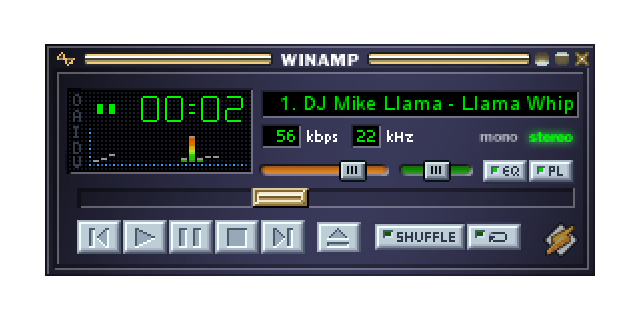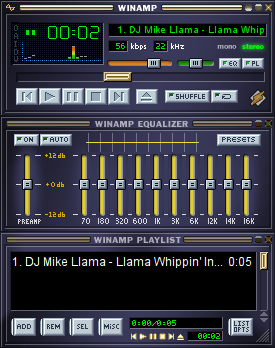Fifteen to twenty years ago, Winamp was the MP3 player that everyone used. It was the first MP3 player not to suck: playlists, shuffle, convenience. I asked friends on Facebook earlier and am surprised at how many people I know still swear by it.
Justin Frankel started Winamp (and the company, Nullsoft) in 1997 at age 18. A few players, including Fraunhofer’s original shareware MP3 encoder and player, were circulating in the college dorm server underground, but there was nothing to organise and play your MP3s with anything like the convenience of a CD. Frankel saw MacAmp and was inspired to write his own. Winamp’s straightforward usability rapidly made it the player of choice.
I first played an MP3 in late 2000. Some J-Pop thing called “Forces”, I forget who by, that I didn’t think much of (though it was catchy enough I can still remember the chorus). I downloaded some stuff off the original MP3.com, but my real digital enlightenment came several months later with the household MP3 server, the thousand-disc CD changer of legend. I could shuffle my whole collection. (Though building a several-thousand-track playlist in Winamp took a while.) I spent weeks just rediscovering stuff.
Winamp was a delight to use: it started, it played stuff, obvious buttons did obvious things, it behaved in sensible ways and had sensible defaults. It did one thing and did it well.
It was $10 shareware; there were no extra features if you paid, but piles of people sent them $10 cheques anyway, netting them about $100,000 a month just from that. And they deserved it.
Our screens were much lower-resolution back in the day.
Since this was the dot-com boom, a pile of people wanted to get in on the action. Nullsoft eventually accepted a buyout from AOL, back when AOL was still a big deal; Frankel alone got $60 million in AOL stock. AOL got Winamp and the SHOUTcast MP3 streaming server and protocol.
AOL dreamt of synergy, where various properties could leverage each other and turn the company into a media content powerhouse. Of course, synergy is another word for 2 + 2 = 1, as AOL’s merger a year later with Time-Warner amply demonstrated. Despite a stupendous pile of online radio streams right there in the Winamp software, and the entire catalogue of Warner Music to hand, they singularly failed to turn into Pandora or Last.FM; instead, they tried to get people to install Netscape or AOL whenever they downloaded Winamp.
And then in 2001, Apple released the first iPod and in 2003 the first marketplace for downloadable music that didn’t suck. As Rob Lord from Nullsoft put it, “there’s no reason that Winamp couldn’t be in the position that iTunes is in today if not for a few layers of mismanagement by AOL that started immediately upon acquisition.” Especially given Winamp didn’t try to take over your music collection and computer like a certain iTunes I can think of.
(Not to mention exercises in frustration like Windows Media Player. Microsoft could have just cloned Winamp, but instead they released software that would DRM your own CD rips by default. Well done.)
(And I was just reminded of the tentacular malware known as RealPlayer. AAAAAAAA)
Culture clash and continual frustration by bureaucracy led to the programmers who had their “fuck-you” money well in hand releasing file-sharing networks and pissing off their corporate overlords; first Gnutella, then WASTE. The original Nullsoft team finally quit in 2004.
AOL maintained Winamp in a desultory fashion and finally announced its death in late 2013. Belgian online radio aggregator Radionomy promptly dived in, and announced their purchase of Nullsoft in January 2014. Sadly they’ve yet to release a new version — as of January 2017, they say it’s still tied up in legalities — though they’ve kept SHOUTcast up to date.
There was also a version for Android, which is no longer in the stores, though you can still find the .APK. I know people who still get this and shove it on their phone, as long as it keeps working.
When I moved off Windows to FreeBSD and then Linux, I progressed through various other media players, most of them dreadful (XMMS is … not Winamp), before discovering VLC, the finest fruit of France, the player that plays everything on everything. I don’t use its playlist capabilities much, but, apart from being my player of choice on the laptop, I found it vastly less annoying on my phone than the default Android player.
But when only the real thing will do, the December 2013 version of Winamp is still downloadable and works. (And is super-lightweight and efficient on ridiculously overspecified modern PCs.) If you’re on Linux or Mac, it works well in Wine. (edit: except the media library. Bah!) And many people continue to use it with ongoing delight. It works, y’know.
What’s Justin Frankel doing these days? Amongst other stuff, digital audio workstation software REAPER. And also, any damn thing he feels like doing.
The original Mike the Llama, apparently, photographed by Justin Frankel.
Also, go to winamp.com and click on the llama’s ass.
- This article also available in a rough Polish translation





“Forces” was from the soundtrack to the anime “Berserk” (a favorite of mine).
And yes, Winamp was, for its time, quite a piece of work. I’m using Foobar2000 these days, which has absolutely unrivaled music management capabilities.
Holy shit, that’s the one! So now I know. Thank you! (The version in my head the past sixteen years is actually better.) I blame Benton Smith, who linked it on Usenet.
The Geiss visualisation add-on for WinAmp is still the best music visualiser I’ve come across. The combination of the two took up many (some would say wasted) summer weekends.
I used to use Winamp and this app called Command Cubes. It was amazing, touch screen multi zone audio player with a client and a server back in 1998 when there was no Apple airplay. It would spawn up 3 instances of Winamp on the server in my basement hooked to my Stearo and the I had the client installed on a PC with a touch sceen monitor. It looked like touch tunes. It was the coolest setup back then. I miss Winamp and Command Cubes! I loved those apps..
xmms is dead, but have you tried “qmmp”? better than xmms, and definitely better than anything in WINE.
I used to be a huge fan of Sonique media player, I really liked their unconventional skins. Also it had a small snippet of a music file which I really like, “Yomama must say, …”. I can’t remember all of it :)
Winamp is not only still downloadable but also compiled to run on modern Windows systems. There is also the Winamp community update pack https://getwacup.com which is getting some traction and could be brilliant if it get’s a public release
XMMS 1 was pretty decent. Played stuff off the command line, didn’t mess you about. As far as I was concerned, an ideal WinAmp replacement for Linux.
XMMS 2 wanted to “manage your music library”. Fsck off, if I wanted iTunes I wouldn’t be running Linux, in spite of what the Gnome people seem to think.
Now I use either vlc or mpv (a fork of mplayer) – mostly because the latter allows things like “I know the badly-encoded file says the aspect ratio / bitrate / channel mapping / etc. is that, but actually it’s this” in a file I can leave next to the media file so I never have to think about it again.
Or mpd, if I want to separate the box with the speakers on it from the box where I’m pushing buttons.
XMMS 1 bit me when I tried to make playlists with it. Winamp made playlists with relative file paths … XMMS with absolute ones. Yeah, no.
Best thing about winamp was that you could right-click on a parent folder and shuffle all the music within, automatically creating huge playlists with no effort. Plus, the mini player really knew how to stay out of the way.
Oh, Amarok v1 on KDE3, that was the other Linux music player that didn’t annoy me. Unfortunately, Amarok 2 on KDE4 was crashy garbage. (And maybe it’s better now, but I probably don’t care.)
As a wedding DJ I used Winamp for background music during mealtime. The adjustable crossfade on skip track on the older simple Winamp was absolutely amazing and I have not found a player to match that feature. Please bring Winamp back.
Winamp for Android is still available at the Google Play store here in the USA, but since it wasn’t very compatible with FLAC and OGG codecs I decided to buy Poweramp and have no regrets.
BTW. I still have Winamp on my PC.
I remember once upon a time there was a plethora of rather half-baked Linux Winamp alternatives, all of which looked nice but were flaky and mostly identical in spirit – all named using strings of random lower case letters. You’d explain the trouble you were having with one and people would respond with: “oh well, xygz is rubbish, don’t use that. have you tried abbm? it’s better than xmmbs but doesn’t have quite as good mp3 or id3 support as aqxdf, though ymmv”. When I first went the GNU/Linux jump I found all this mindboggling, especially the unreasonable level of pain necessary to make soundcards and codecs work properly with gstreamer and OSS – upon which all of this alphabet soup relied.
The trouble is that sound systems on Linux have always been a garbage fire. I’m not sure any living human has actually figured out JACK, whatever they claim. Fortunately PulseAudio solves all possible sound problems on Linux, except the ones you have.
I used to love listening to music on Winamp while enjoying the visualizations on a 200″ projector screen.
I really hope they continue to work on newer versions.
Yep, still using winamp here, on windows and linux (via wine). Milkdrop 2 is still the best visualisation by far, and also works great on linux with wine’s directx layer. Just add the rocksteady volume normalisation plugin for best results.
http://winampheritage.com/plugin/rocksteady-2-1/1099
Interesting read, thanks for sharing.
I wished it had features a paragraph on the winamp3 rewrite debacle which made space for foobar2000 with its native support for better and modern formats though lacking on the milkdrop visualization thing and huge catalog of online streams. Still exists and is actively developed today along with an offshot called boom designed for people who would rather use a CD player than a computer to listen to their music. Foobar2000 recently came to be offered for android, ios and windows phone.
Ha, someone did a short rewrite of this article in Finnish: http://www.tivi.fi/Kaikki_uutiset/15-vuotta-sitten-tama-sovellus-oli-ylivertainen-nyt-sita-ei-kayta-juuri-kukaan-vaikka-yha-pidetaan-parhaana-6621784
yapoo: yeah, I completely missed the Winamp 3 era – I spent 2002 on a Debian laptop then a FreeBSD desktop, only using Windows at work, so didn’t know anything to say about that. Shoulda mentioned the consensus that it sucked, though (bloating and instability), you’re right.
Winamp developer has now created one of the best recording software DAW called REAPER ( http://www.reaper.fm )
http://digitaltools.node3000.com/interview/170-justin-frankel-on-winamp-and-the-reaper
Winamp is a great media player, especially for musicians who want to practice with tracks, and Pacemaker plugin. Adjust Speed, Pitch and Temp, without messing with audio tone
https://www.surina.net/pacemaker/
This 2004 interview with Frankel in Rolling Stone, just as he was leaving AOL, does more than ask the same few questions about Winamp yet again, is also awesome reading and fills in a lot of the story. Also this 2008 interview in Wired.
As a Ballroom Dance Instructor/DJ, I still use Winamp. It still does two things that no other player does even today, it allows me to drag and drop files from my PC to a playlist without having to deal with iTunes and MP3 tags, AND it supports the Pacemaker plugin that remembers the tempo adjustments so that when I find the right tempo for particular song, it plays that way each time. Add to that the easy playlist rearrangment in real time, the Sqlsoft crossfader, and Volume Logic plugin with output normalization and sound enhancements and it is the perfect combination. I tried every other current player, Foobar, Media Monkey, Music bee and a ton of others but still nothing matches the power ans simplicity of Winampmfor my application.
i still use winamp in 2018. my fav player on my pc.
Even an article about winamp has apparent longevity. This article is currently the top result on Google for ‘does winamp still exist’. Great read, I’m going to need to download winamp anon.
Also, RealPlayer was a massive bio-hazardous dumpster fire doused in thermite then nuked. The pang of rage I felt just seeing that name again (and writing it!) is something bestial.
I AM THE WINAMP FAN FOR THE LAST 24 YEARS, WHEN I GOT MY 1ST PC. IT WAS EASY TO USE. SIMPLY JUST DRAG THE FILE / FOLDER OF MP3 MUSICS INTO WINAMP PLAYLIST & YOUR PLAY LIST IS READY. I HAVE STILL ICEYBLUE COLOUR BAR OF WINAMP ON THE TOP OF MY COMPUTER SCREEN. I HAVE KEPT WINAMP APP IN MY MOBILE SD CARD & I JUST INSTALLED IN MY LATEST ANDROID 10 PHONE. I DON’T KNOW MUCH ABOUT THE LATEST TECHNICALITIES OF MUSIC SW & HW, BUT I KNOW ONE THING, MY WINAMP IS THERE FOR MY MUSIC. I KHOW ITS PLAYLIST, BUTTONS & FEEL SO EASY TO USE, BECAUSE I AM USING IT FOR THE LAST 24 YEARS ON PC & PHONE.
Best thing about winamp was that you could right-click on a parent folder and shuffle all the music within, automatically creating huge playlists with no effort. Plus, the mini player really knew how to stay out of the way